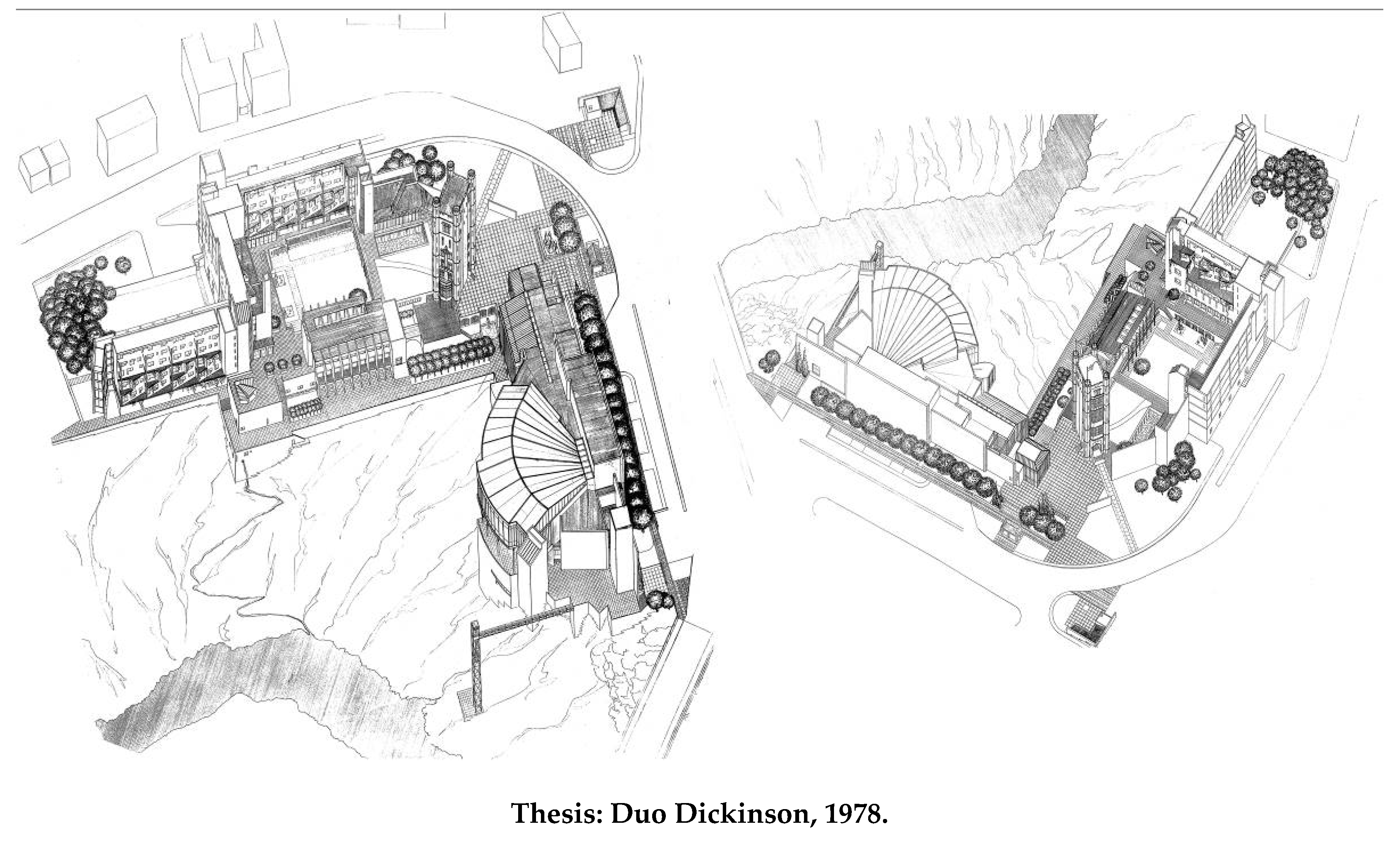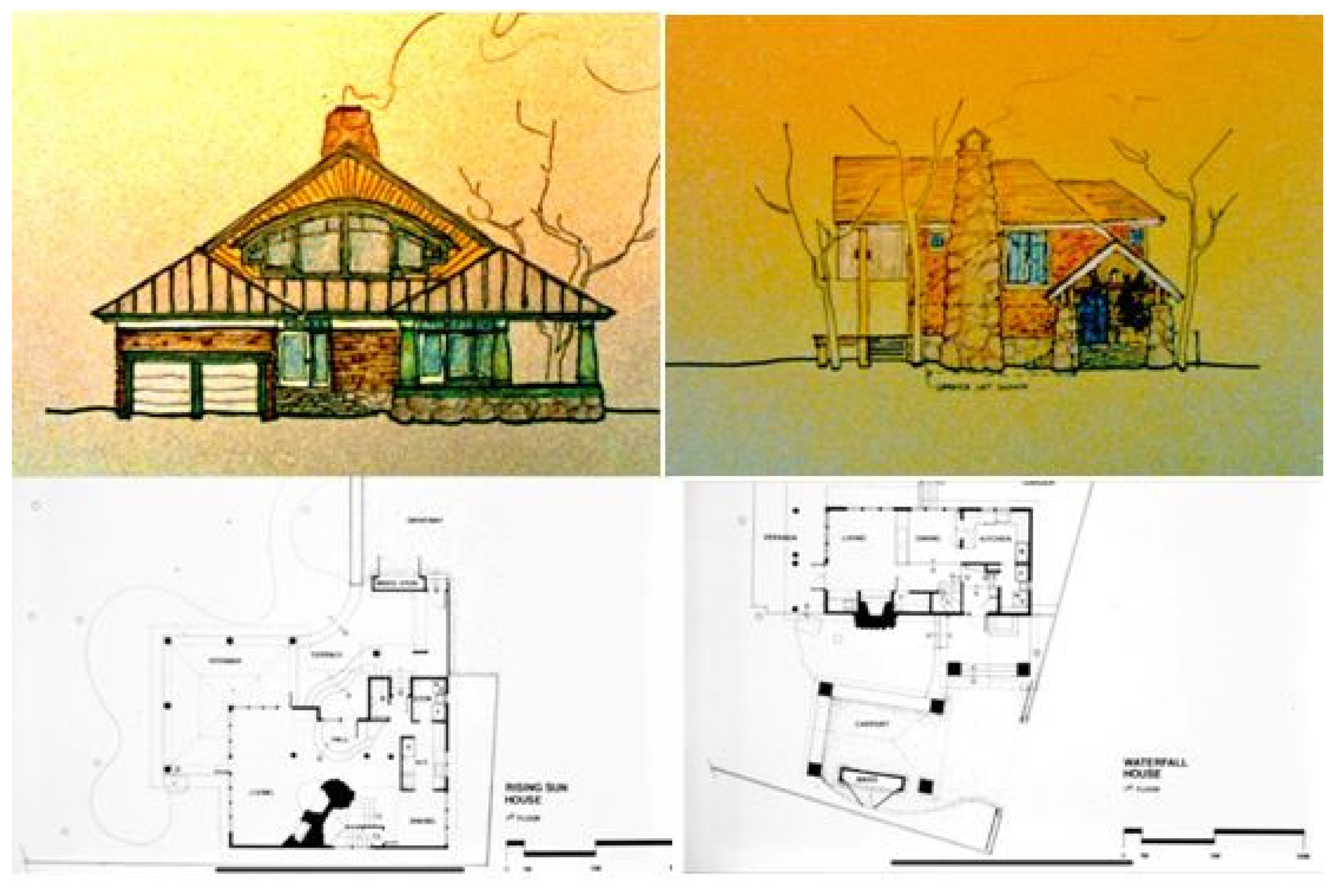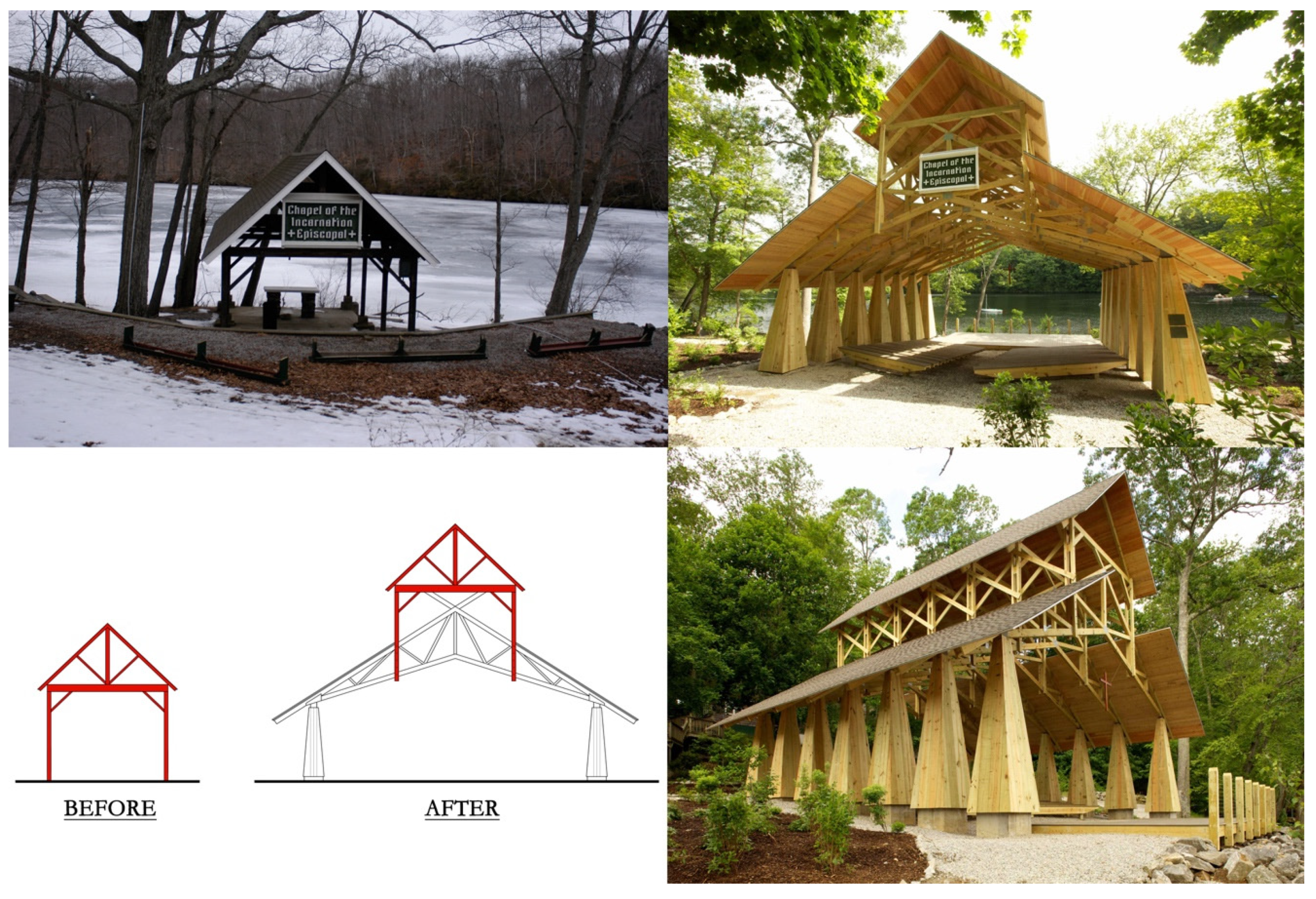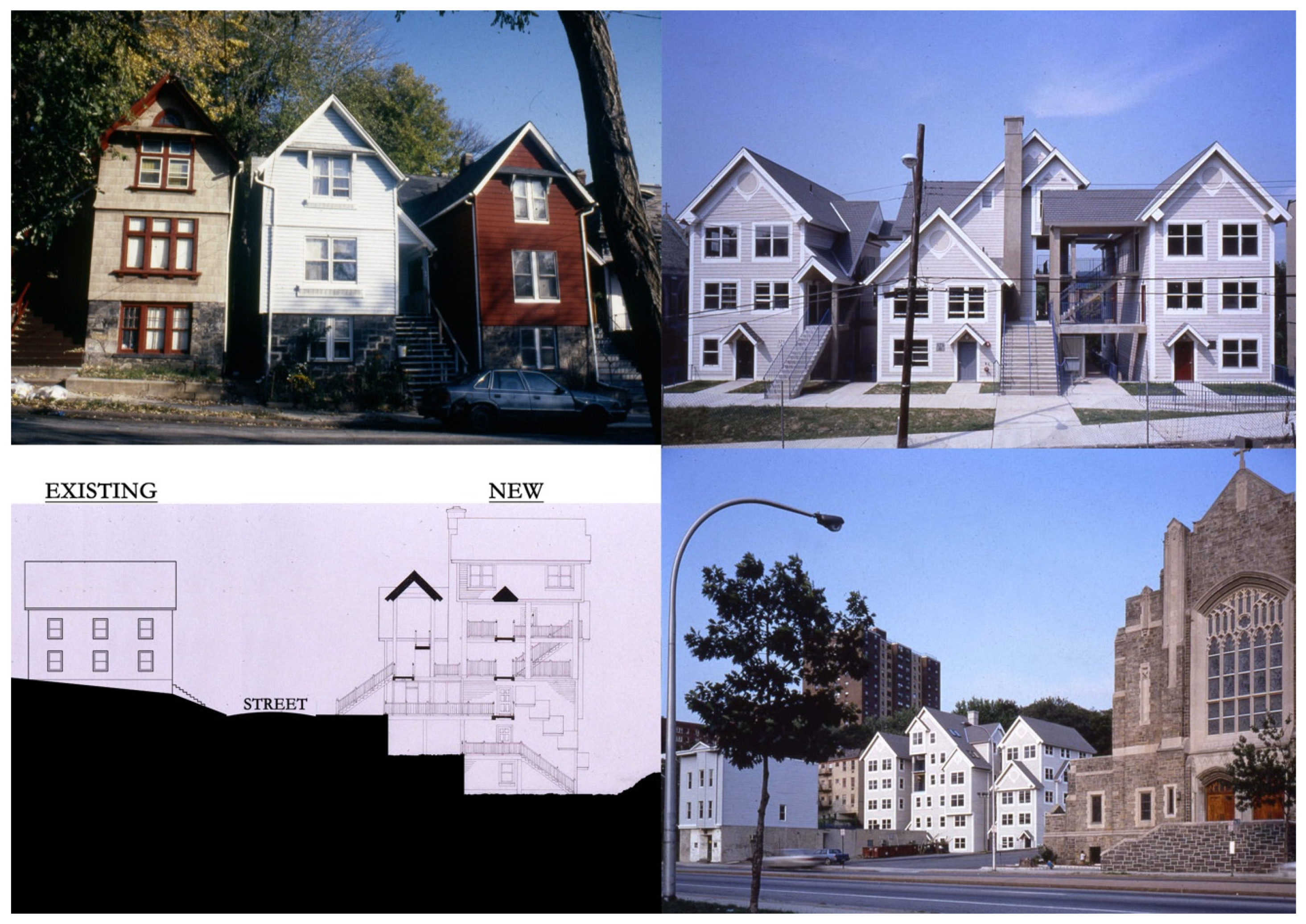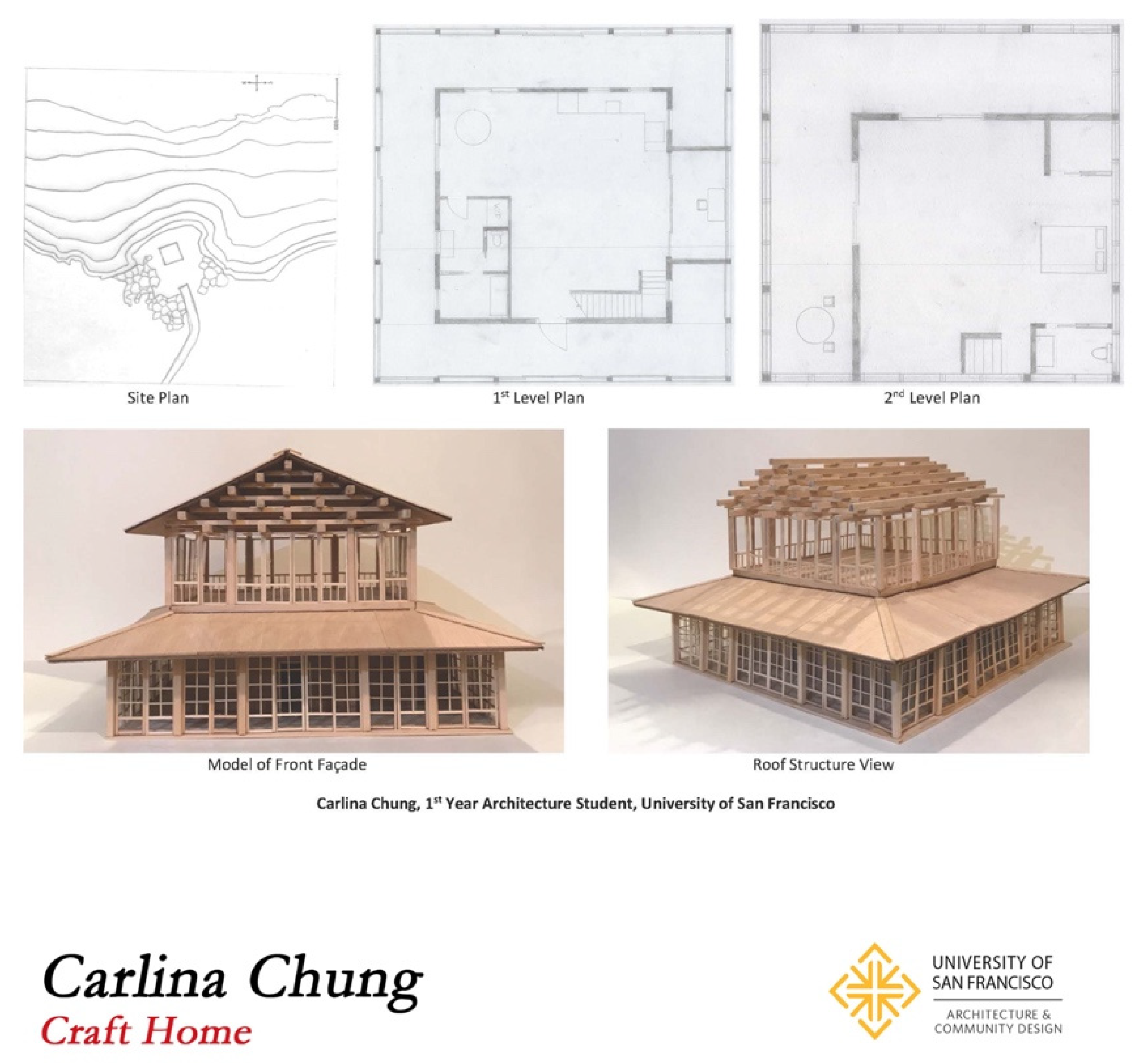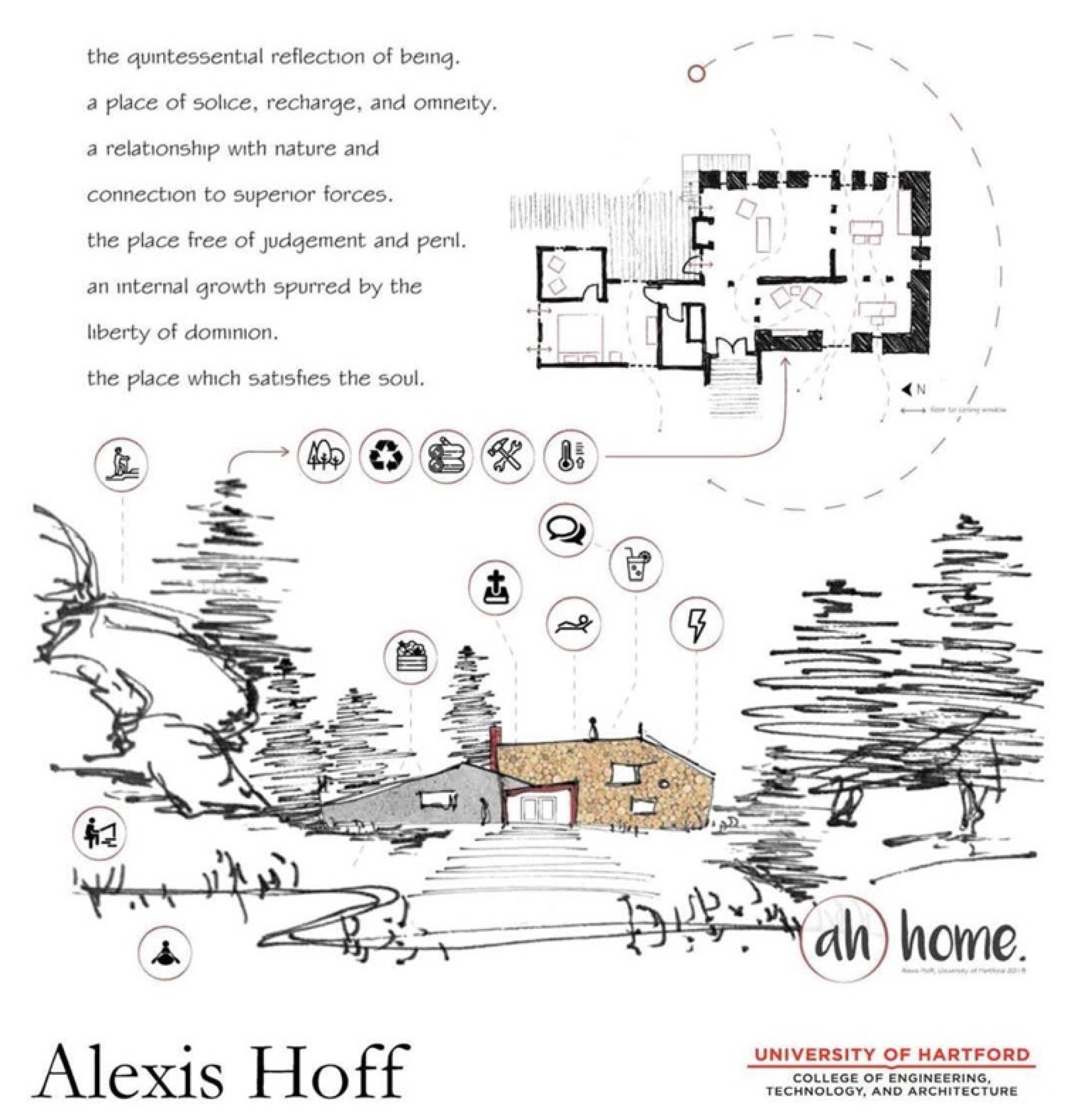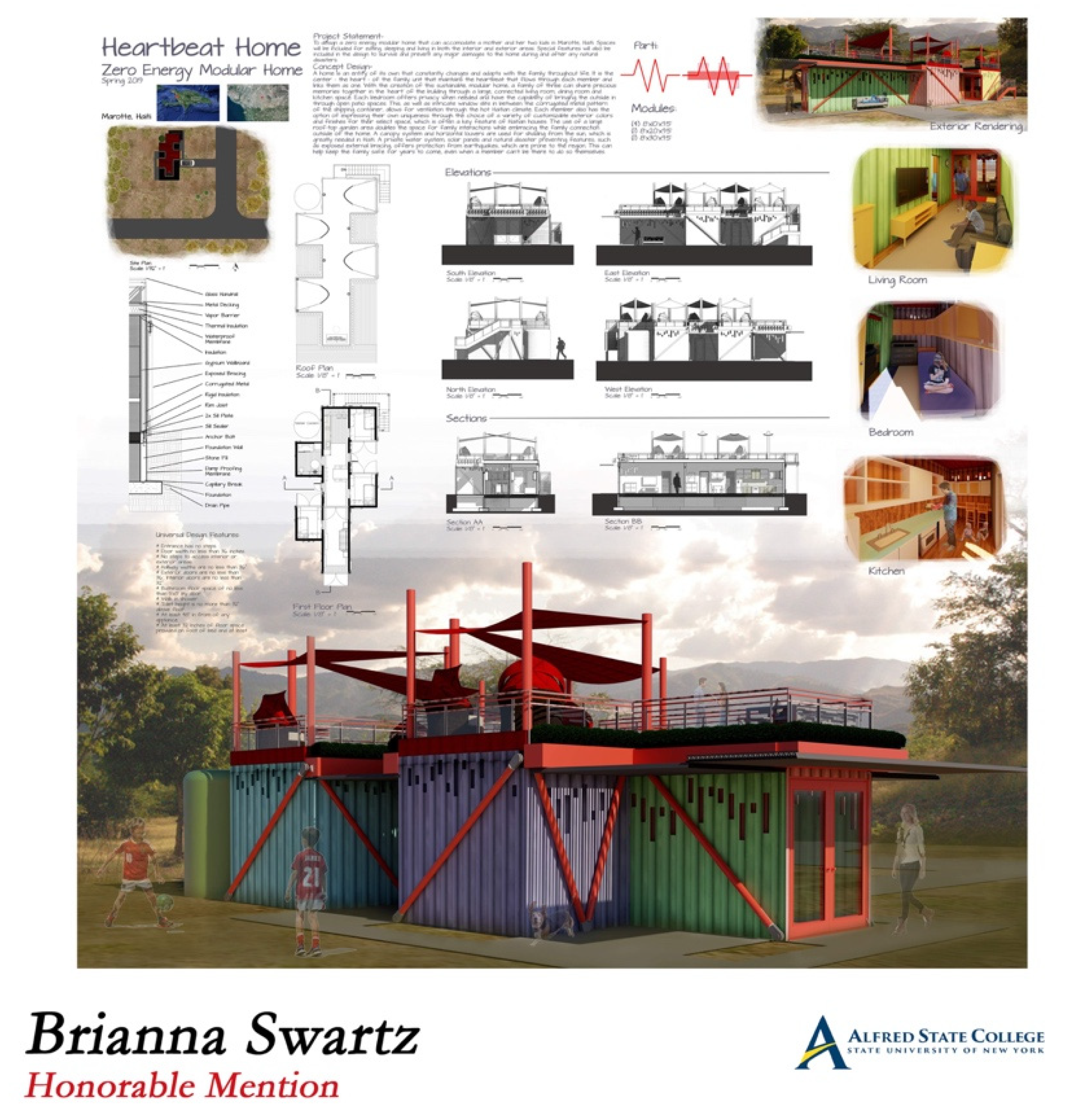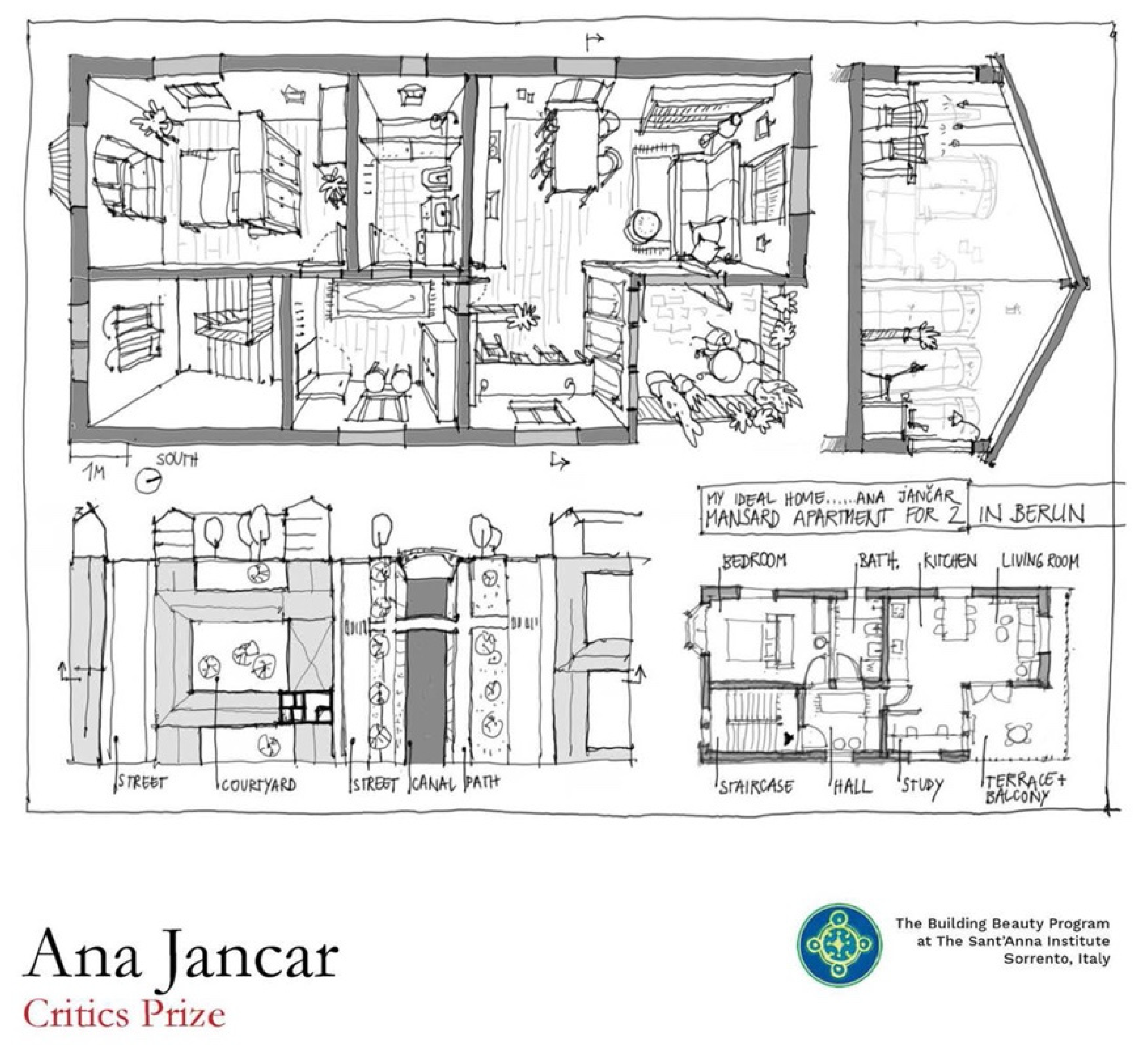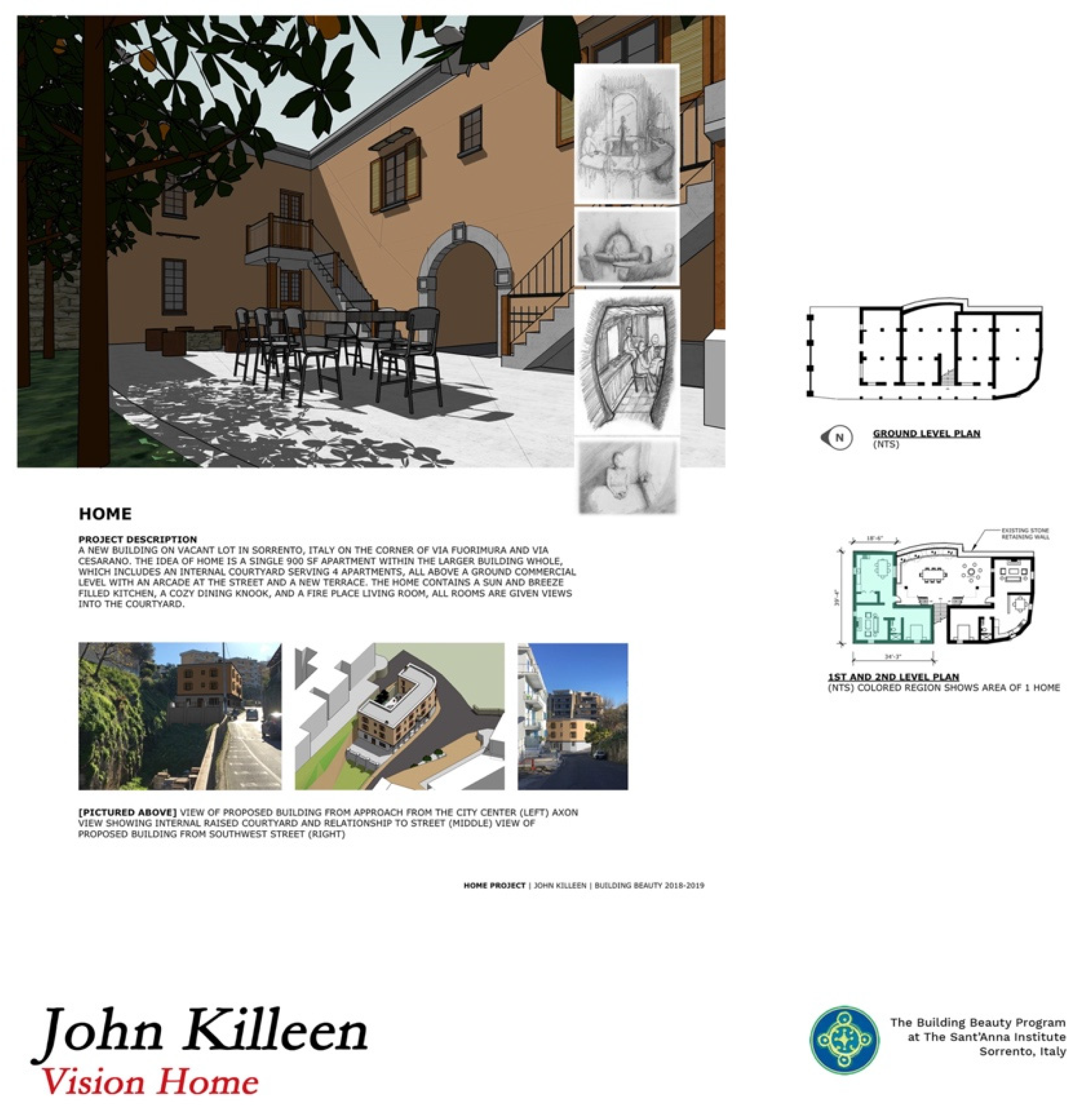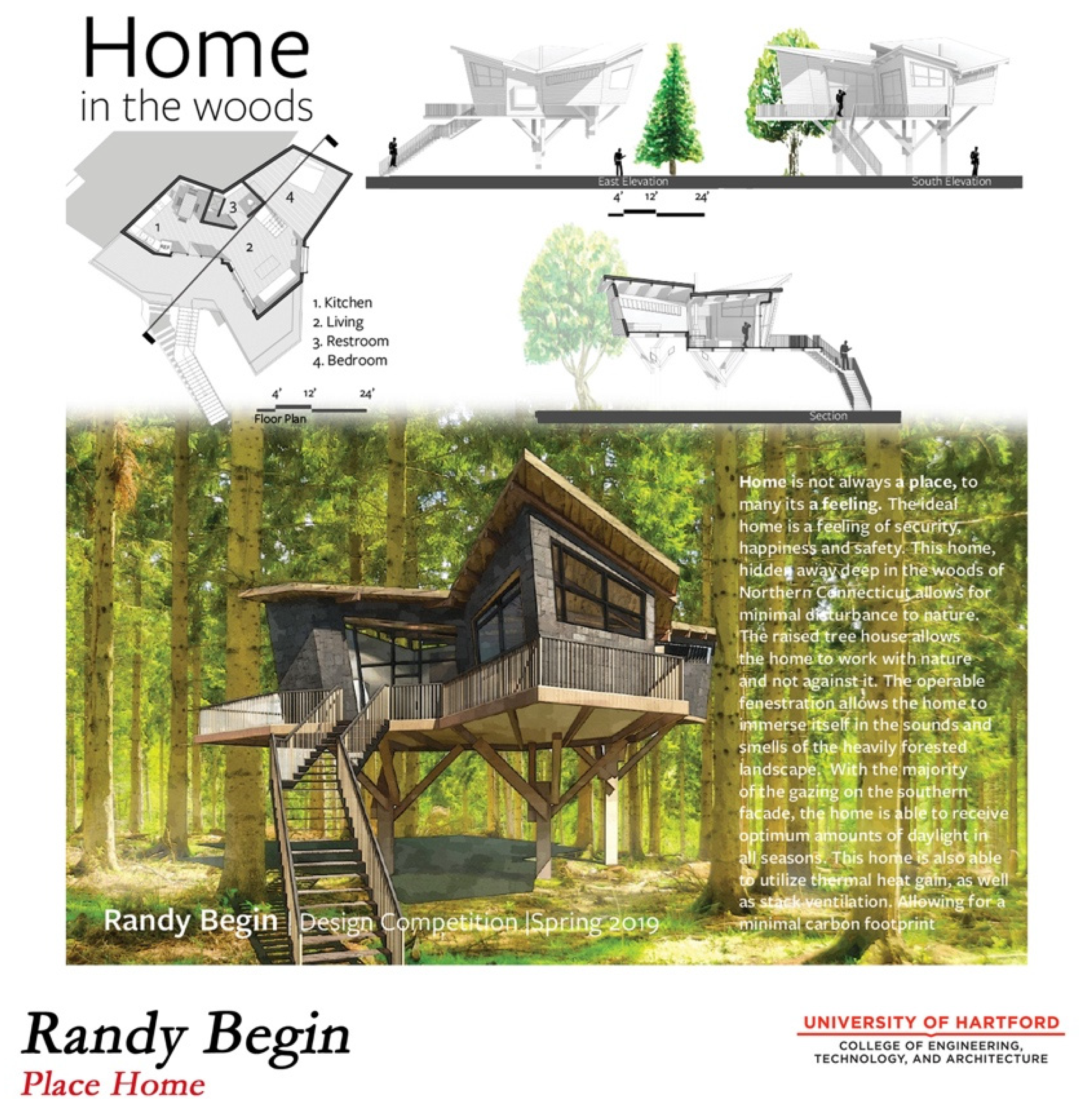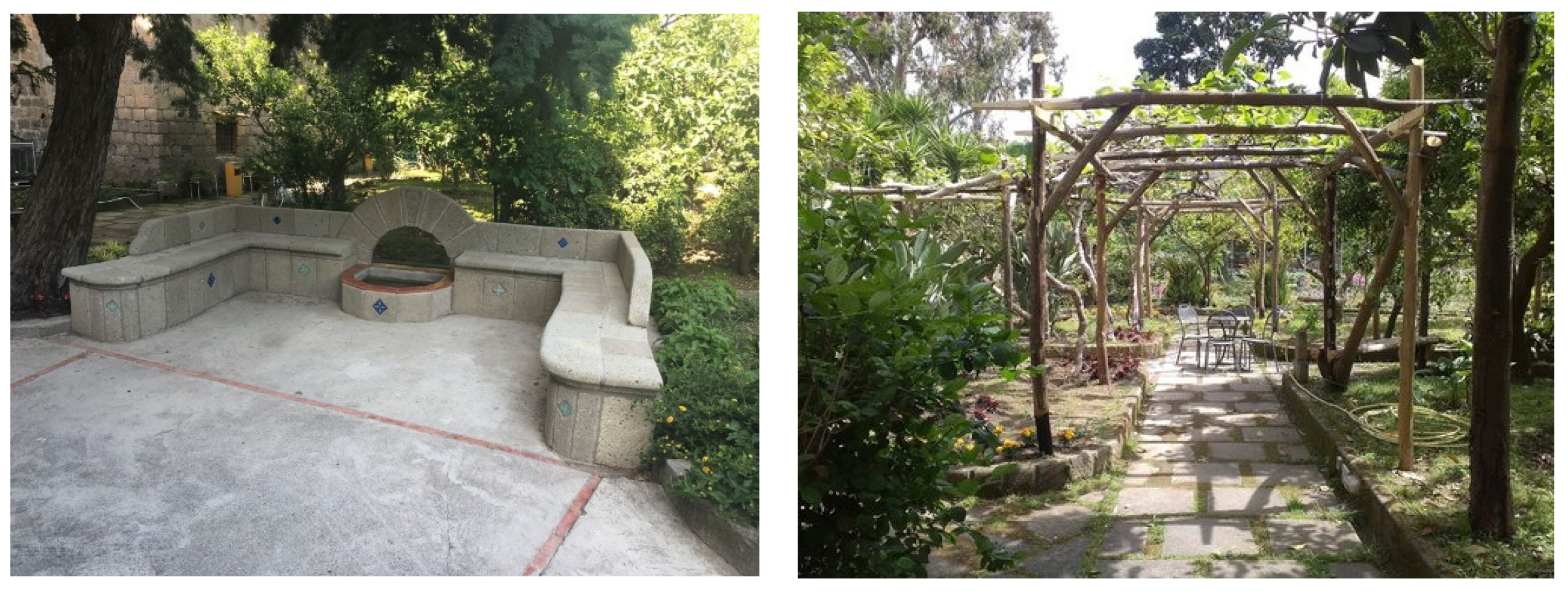1. Christopher Alexander Offers an Alternative to the Genius Model—The Polymath
Christopher Alexander’s profession, architecture, is neither one of rote building nor detached theory, because architecture is the synthesis of thought and action in construction and fine arts expression. The singularity of the Genius architect models venerated by the architectural canon [
1] makes that canon ever more irrelevant to both architects and those who would use them.
The author, educator and architect Christopher Alexander has spent a lifetime writing, teaching, and building. Walking the talk of ideas by making substance out of belief should not be surprising, it is what some architects do every day. As a building architect who writes, I perceive Alexander’s words and buildings differently to journalists or professors. This essay describes that impact, and compares the prescription of style, offered by celebrated “’Genius architects”, to the relevance of a polymath’s perceptions and capabilities.
Architects who are celebrated in popular culture live in a world that defines its own success. In literally writing their own rules, architects such as Le Corbusier succeeded on their own terms. Ideas are the core of most academic writing that addresses the singular Genius model of architect, so those analyzing design are often dissecting the lab rats of architecture, bred by others to find a “core” that is unavoidably idiosyncratic, rather that universal, despite the intentions of the analyzers.
Charles Moore and Kent Bloomer describe this world in their book “Body Memory Architecture”
“It became apparent to us that architecture is generally assumed to be a highly specialized system with a set of prescribed technical goals rather than a sensual social art responsive to real human desires and feelings. This limitation is most frighteningly manifested in the reliance on two-dimensional diagrams that lay more stress on the quantifiable features of building organization than on the polychromatic and three-dimensional qualities of the whole architectural experience.”
To find a human future in architecture, there needs to be a realization that architects are not a singularity, we are all part of our largest perspective, as a culture, as polymath’s. Miriam Webster defines a polymath as:
polymath
noun
poly·math | \ ˈpä-lē-ˌmath\
Definition of polymath
: a person of encyclopedic learning
The cliché archetypical architect, such as Howard Roark of “The Fountainhead” [
3] is defined as the omniscient megalomaniac, who may be in error, but never in doubt. If you write your own rules for success, you will always succeed. If you are a polymath, your motivations go beyond your singular view. Alternatively, in the world beyond celebrity and product, joy and fulfillment is the criteria for value, meaning, and relevance - and come from perception rather than rationalization.
The polymath stands in contradistinction to the embodiment of an architectural canon. As Markus Breitschmid defines it, the architectural canon [
1] is a way to divorce it from the rest of the world:
“The ’Canon in Architecture’ buttresses the autonomy of architecture in two ways. For one thing, it structures our thinking about architecture per se. Secondly, it enables us to contemplate architecture autonomously (’architecture through architecture’) instead of reflecting about it as an instrumentalization of an ulterior purpose-based mostly on situational and practical expediency, to prove a point for some extra-architectural ’special interest. ’”
This architectural canon [
1] has created an academic and journalistic “Deep State” [
4] where the Genius paradigm is the central focus of study. As Nikos Salingaros points out in the Dallas “AIA American Institute of Architects” periodical “Columns” students have a barrier to understanding, created by the implementation of that architectural canon [
1]:
“After reading all that stuff during the years spent in architecture school, the students’ minds are rewired so that they can no longer perceive the geometry of nature or their own sensory signals. Fashionable but inhuman forms are imprinted into their brains, so any design ideas that come out are simply regurgitations of implanted images.”
Creation, as made and understood by polymaths, embracing all that is human, is different. Creation as practiced in this way is a window to both the infinite variety in human experience, and the universality of human values and experience. The Genius architect model of creation does not reflect on this essence of humanity in favor of the overwhelming power of personal insight, conclusions, and rationalizations, so the architectural canon [
1] that derives from that basis is exquisitely self-serving.
Alexander offers an alternative, as it upends both archetypal architect outlook, and the symbiotic academic and journalistic dependence on its Genius:
“I do not, directly, blame all the architects who have made these buildings in so many places on earth. I believe it is inappropriate to feel anger towards them ... Rather, I believe that we must acknowledge that the architects (often our own colleagues) who drew these buildings, and then had them built by methods and processes far from their control, deserve our sympathy for being placed in an impossible position. What has caused the new tradition of structure-destroying forms of this era, are mainly the machine-like processes of planning, conceiving, budgeting, developing, construction contracting, construction labor, and so forth. The architects who fully accepted the modern machine have hardly been more than pawns in the game which is much larger than they are.”
Rather, Alexander’s expressed obsession with understanding the reasons we create as part of defining the way we design allows him to understand why this architect archetype exists:
“Self-consciousness brings with it the desire to break loose, the taste for individual expression, the escape from tradition and taboo, the will to self-determination. But the wildness of the desire is tempered by man’s limited invention. To achieve in a few hours at the drawing board what once took centuries of adaptation and development, to invent a form suddenly which clearly fits its context - the extent of the invention necessary is beyond the average designer.”
By addressing the fact that architecture has a feedback loop beyond a project’s public laud or rejection by journalists, peers and the academy, all building architects experience what Christopher Alexander has spent a lifetime defining, and that his writing has made into language. That combination of creation and understanding has universal intentions, informing our culture of its essential motivations and values.
Having grown up in the mid-twentieth century architecture world that spawned Christopher Alexander’s insights and designs, I understand Alexander’s essential premise that style obsession is not the reason we create:
“The idea of style is meaningless: what we see as a style (of a person or of an age) is nothing but another individual effort to penetrate the central secret of painting, which is given by the Tao, but cannot itself be named.”
In the twentieth century, architecture had become a forum for the Genius persona as held up by celebrated architects in our culture. Figures such as Frank Lloyd Wright [
9] or Zaha Hadid [
10], are part of an ongoing fashion show of architecture that presents a walkway of unknowable black boxes that define problems in order to reactively, inscrutably, generate solutions. Despite the architectural canon [
1] there are architects who do not design for other architects. I am one of them, and Alexander has defined the listening polymath as an alternative to the Genius model which has defined the architectural canon [
1] in the Modern Era.
2. The Formation of the Alternative to Genius
The human mission to create beauty is at the core of Alexander’s life work. These insights are universally human and unavoidable to architects, but easily dismissed by the architectural canon [
1] of architectural education and journalism.
2.1. Personal History
In reading “A Pattern Language” [
11] in 1977 the realities of how humans perceive, respond, and consider options to design any and everything was a daunting exercise for a 22-year-old. However, when I received “A Timeless Way of Building” [
8] in the Christmas of 1979, I began to connect the dots as an architect beginning to make things, a process so carefully defined by Christopher Alexander. Alexander’s insights allowed me to understand the language of design: so much so that I taught Alexander’s writings at Roger Williams University in 1988.
My education keyed my understanding of Alexander. The empirical, top-down education provided by Cornell University in the 1970s had a powerful pedagogy. There was right and wrong. There was an architectural canon [
1], which was right, and it was defined as “Modernism” to the point where professors were fired to increase diversity of thought beyond that architectural canon [
1] the year before I attended (1973). Furthermore, Corbusier’s Modulor Man [
12], painted to life scale upon the wall facing all freshman architecture students (and used to size their designs) was painted white, completely covered from view. My final thesis (see
Figure 1.) five years later fully reflected Cornell’s attempt at intellectual diversity.
If the architectural “Canon in Architecture’s” [
1] imposition had been successful in my indoctrination, I could not have created my thesis (above). Additionally, I may have never read Christopher Alexander’s writings. Instead, I was taught at a time at Cornell where alternative ideas were taught in addition to that dominant architectural canon [
1]. Design Morphology was taught by Archie Mackenzie, Organic Architecture was offered up by Wojceich Lesnikowski, an even the work of Italy’s Superstudio as relayed by Massimo Scolari infused the students with a sense of competing ideas.
I came to realize that every human has a personal perspective, so every maker of things has a way of perceiving, creating and then making. My life’s work validates the essential priority of beauty in the human condition. However, in that mission to define the universality of human creation, there is value in expressing how one architect defines it, these words by Alexander ring true:
“To work our way towards a shared language once again, we must first learn how to discover patterns which are deep, and capable of generating life.”
The essential distinction between top-down style-based/judged execution and human-based Bottem Up” creation immersed in our culture is both simple and challenging.
In analyzing what is made, architects and those who write about architecture are often deaf to the why of the values that infuse creation and blind to the outcomes that should manifest those values. Like any designer who builds, I am judged by what is created. However, I am useful to those who want that “what” because of a relentless pursuit of the “why” in making things.
Architecture as a mission suffers when those two essential frames of creation are split: with “Why” central to everyone, and “What” central to the architectural canon [
1], and its Deep State.
As the Genius model offers the world, it is not a requirement to do more than have a vision that expresses the designer. This silo-ing of expression to the Genius architect model is easier to understand, critique, teach and promote than the rigorous process finding of beauty latent in every creation. However we live here, now, not in the mind of a creator, and my own work, making over 800 things, has embraced more than my own insights.
2.2. The 15 Fundamental Properties of Wholeness and My Work
In his book United Architectural Theory [
13], Nikos Salingaros, math professor at the University of Texas, notes that Christopher Alexander has defined life in buildings. Salingaros describes Alexander’s 15 Fundamental Properties of Wholeness that are present in architecture that has “life”. see
Table 1. [
14]:
Thirty years ago I was hired by clients in Japan after looking at 20 other architects from all over the world (see
Figure 2). I asked why they hired me, as I was not very famous. They replied, “We hired you because you make happy buildings”. If you are happy, then you are alive. These designs resulted: my practice does not intentionally apply these 15 principles as Alexander defined them, but I have unknowingly followed them.
The 15 Properties are universal to the point of being obvious and incontrovertible. These Principles are architectural, but are without “style”. The 15 Properties describe why any building is “alive” in a world that is not confined to the architectural canon [
1]. My work at Incarnation Center, Ivoryton, CT (see
Figure 3.) reflected the 15 principles simply because my approach was fundamentally consonant with Christopher Alexander’s 15 Properties of Wholeness:
Without preconceptions, the project above demonstrates 14 out of 15 of The Fundamental Properties of Wholeness as described by Christopher Alexander and Nikos Salingaros. These Properties include “Levels of scale”, “Strong centers”, “Boundaries”, “Alternating repetition”, “Positive space”, “Good shape”, “Local symmetries”, “Deep interlock”, “Contrast”, “Graded variation”, “Roughness”, “Void”, “Inner calm”, and “Not-separateness”. The one missing property is “Echoes”, and I posit its link to the past is its “Echo”.
Another project, built 30 years ago, Cephas Housing in Yonkers, New York (see
Figure 4.) also manifests almost all of the 15 Properties of Wholeness
Again, this project has 14 of 15 properties, missing only the universal property of “Roughness”. Architecture that I have helped build is often created without any abstract motivation beyond solving a problem by creating a building. The work I do involves the considerations that Alexander spent his life pursuing, not by design or preconceptions, but because he, like me, approached each project with an openness to all the design criteria no Genius model prescribes. Those universal realities become the 15 Fundamental Properties of Wholeness.
These designs do not engage in outcome-based architecture, where the nature of the product/object is the way of making it preconceived. Designing as a polymath, addressing the world, embracing process of creation, engaging beyond the designer allows for life in creation. The “what” focus of making a product is not the way most of us address the world. Instead, the “why” of the process is how humans address their future.
The 15 Fundamental Properties are most available to the polymath, because the possibilities of creation start a process, rather than a dominant canon directing a “correct” outcome. The Genius model does not offer alternatives, it offers outcomes. The singularities of objects may indeed have those 15 Properties, but it is when the “black box” of Genius becomes the basis of design that possibility is less.
Why do we care beyond function and cost when we make things? The human desire to express beyond adequacy manifests itself in what clothes we wear, the food we eat, the place where we live. It is not just safety and survival that drives us, it is the joy of finding the spark of connection to a greater reality than simply to satisfy need. This need validates the power of all the “Why’s” used by Alexander to create.
2.3. The Meaning of Making, Now and in the Future
We care how things project our values and reflect our individual humanity. If the default value required by humans was simply subsistence there would be no fashion, chefs, or architects. Alexander saw this:
“There is a central quality which is the root criterion of life and spirit in a man, a town, a building, or a wilderness. This quality is objective and precise, but it cannot be named.”
The need for clarity in realizing these truths has become more important as Michael Mehaffy says in “Meetings of the Minds”
“We are entering an age of critical challenges to humanity, among them depletion and degradation of resources, climate instability, and disruptions to sustainable economic activity, often caused by the unintended consequences of our own actions.”
There are conclusions that only a polymath can confidently advocate in being part of a much larger world than the architectural canon [
1]. Humans are the only beings that knowingly create art for its own bliss. The joy we have in creating is as real in its impact on our values as hunger, lust, or shame. We cannot eat beauty, be sheltered by it, or use it to propagate the species, but beauty is at the essence of our survival, it is why we value living. Alexander saw that humanity:
“The structure of life I have described in buildings - the structure which I believe to be objective - is deeply and inextricably connected with the human person, and with the innermost nature of human feeling.”
If you try to rationalize art, or distinguish it from our humanity, it begs the reason its joy is essential. If you can intellectualize a subset you control, such as architects and the buildings they design, then anything can be defined as beautiful, because you, the creator, are also the beholder. This is the central danger of the coming unavoidable technology, and the challenge to those who make things. If you see that art is all around us, as present in our lives as food and sleep, then you accept the challenge of making beauty in this world, not just in your own. If architects design for themselves or other architects and not for the entire world around them, something is lost. As technology stands ready to completely reinvent how everything is created, Alexander’s words are starkly relevant:
“We must face the fact that we are on the brink of times when man may be able to magnify his intellectual and inventive capability, just as in the nineteenth century he used machines to magnify his physical capacity. Again, as then, our innocence is lost. In addition, again, of course, the innocence, once lost, cannot be regained. The loss demands attention, not denial.”
Connection to a greater culture, beyond the architecture profession and its canon, becomes a baseline criterion for creation, and connection does not come from being a Genius, it comes from being aware of the world around us, by being a polymath. Makers of things attempt more than to satisfy the minimums. Makers spend their lives defining the crack between the prosaic and the sublime, combusting those parallel worlds into the meaning of creation. I find the meaning that
“cannot be named” [
6] as the essence of value in attempting to do more than the minimum or consigning an object into the architectural canon [
1]. However, without the lilt of vision, or an aesthetic, any attempt at beauty becomes artless commentary—as dry as a history book or a tweet. It is only when we have one foot in who we are and value and the other in what we see, feel, and know that art reflects our lives. This essential realization bonds Alexander to me:
“When we know these moments, when we smile, when we are not on guard at all-these are the moments when our most important forces show themselves; whatever it is you are doing at such a moment, hold on to it, repeat it-for that certain smile is the best knowledge that we ever have of what our hidden forces are, and where they lie, and how they can be loosed.”
The world itself is beauty, humbling to those who try to make it beyond its natural creation. Our attempt to create should be the opposite of arrogance. Humans know failure at creating anything beyond simple survival and that makes what is natural, sacred—at least to me. The intentional creation of art in the world, independent of simply living, is uniquely human, despite the beauty of everything around us.
We all want more than survival, or even love, we want meaning and beauty. No paintings are hung on a burrow’s wall, but it is still beautiful. A bird’s chirp, its feathers, are astonishingly gorgeous and the bird is oblivious to them beyond their use. That does not make me arrogant or the bird ignorant. Any baby that we encounter has beauty that is deeper than anything we can make. However, the point is that we want to make that beauty. No other being wants to make beauty, they just are.
3. The Reason Alexander has Meaning for Architects
Ideas as expressed by Christopher Alexander have mechanisms for discovery and realization. In the profession of architecture, the reasons we make can be shared, then understood and taught. Architects are living in a changing environment, where it is easy to forget why they are in the profession at all. There are essential truths in Alexander’s perspective that can be applied to help architects discover their own.
Unlike didactic logic, or fashion zeitgeist, or “style”, Alexander’s fundamental perspective on how humans engage in creation and how they perceive their environment is elementally true. Whether used to create, or simply observe after creation, the 15 Properties of Alexander are simply realities for everyone in the buildings that they deal with. Rationalization of applied aesthetics is revealed by Alexander’s words and work to be intellectual justification for subjective ideas.
Technology is reinventing architecture (and medicine, and law and everything else). If ever there was a time to realize the essential, it is now. If we lose faith in the beauty that motivates in favor of a technology that makes our humanity unnecessary, there is no room for connection beyond a cash and carry culture. Christopher Alexander’s insights may be his, but they observe the essential baseline of all design that exists with or without new technology. Architects know things are dramatically changing, we see it every day. The properties described by Christopher Alexander are revealed by his work, not created by it. Four years ago, with the American Northeast still reeling from a building recession, the distractions of getting things built were less deafening than in previous times, so listening to the reasons we made things could be more intentionally addressed. So four years ago, the Connecticut AIA asked the great architect Barry Svigals, FAIA [
17] and I to do a group session [
18] with any and all architects to question why we were engaged in the practice of architecture when there were so may depressing realities of greed, client caprice and technical expectations that render joy too rare.
We started the session by asking the over 70 participants two questions, randomly handed out to the participants:
“What happened today that made you glad you were an architect?”
And
“What happened today that made you question being an architect?”
In this way, Svigals and I forced language into the idiosyncrasy of the desire to design, a desire often frustrated by the daunting realities of actually building. Ideas are controllable in articles such as this, but ideas, the nourishment of beauty in creation, are often so inarticulate that they are ignored, so motivation is lost. Execution is necessary to the point that the essential mission of who we are is lost, whether we are architects or in any station in life. By using language, Svigals and I forced 70 architects to address what their mission was.
In the 90 min of programmed questions and sharing, we came up with a word:
Beauty
The universal, personal response to these two questions was exceptionally powerful. When Beauty could be expressed in the lives of these design professionals, there was validation. When Beauty was denied there was depression.
Listening to perhaps 40 individual verbal perspectives of those doing what I do had a real impact on my insights. A language was annunciated. The goal is to make something that captures the essential spark of the ineffable potential of any design. However, what seemed to be revealed at the AIA convocation was the undeniable, ultimate criteria for success: Beauty. Other aspects of success in architecture are simply less compelling, despite the obvious promotion of success by popular culture. The capacity to make beauty is independent of making money or being published or teaching or winning awards. Architects can facilitate the ineffable power of joy that makes things beautiful, beyond code compliance, function, or profit.
Breaking with the architectural canon [
1] is a risk for architects. Making beauty an ultimate goal of architecture can be seen as a sentimental rationalization for shallow thinking or an excuse for bad design. However, irrelevance and “style” are more easily accepted when the designer is the denominator of meaning. Alexander’s mission, to define and effect the universal truths of creation, is shown in the two-year-old Building Beauty program that he and his colleagues have created over the last 5 years. At its essence the program eschews to the architectural canon and the Genius model of creating architecture because it is based on the thoughts and realizations of Christopher Alexander.
4. The Building Beauty Program
This is a program [
19] that translates the realities of Alexander’s insights into a way to educate. Christopher Alexander’s methods are used to define how any design can be connected to the world and the designer while being taught in Building Beauty.
4.1. Origins
The program was first posited in a conversation between architect and educator Sergio Porta and Alexander seven years ago in England. The two, along with Alexander’s wife Maggie Alexander, worked as professors and architects from Seattle, Oakland, Rome, and Israel to make Building Beauty.
Then a piece that I wrote online for the Common Edge Collaborative struck a chord with those making this program. As I said:
“I think we’ve forgotten the necessity of beauty in our purpose. It’s easy to miss that as we respond to the hard changes in our profession and opt to ’CLICK’ and drop in design clichés onto our infinitely malleable drawings. It’s easy, too, to just copy and paste the routine code solution, the latest magazine/website fetish, or tear sheets from the clients—or simply accept stock specs to deal with budget pressures. Those excuses deafen us to the potential for beauty.”
After Seattle architect Susan Ingham read this, she contacted Maggie Alexander, and I was contacted by those creating Building Beauty [
19]. We met and in short order, the gist of the program’s approach was conveyed to me. The program is based on one truth: that buildings are not created exclusively by or for detached aesthetics. The architect-as-Master-Builder faded in the last half of the 19th century, and with it, apprenticeship as a means to education. The fine arts education that replaced it is now how architects use aesthetic abstraction and presentation techniques to learn. This way of learning often leaves the joy of building unexplored (especially if BIM or “Building Information Modeling” takes care of the messy “details”). Architectural education is still largely based on this fine arts studio model of teaching abstract aesthetics. However, education has to change because the way we create buildings is fundamentally changing. We know this because technology is replacing humans with algorithms. In 2018, the AIA’s chief economist, Kermit Baker [
21] stated that more than half of architecture graduates in America will not find a career in architecture in the coming decade.
If architectural education changes to directly embrace the capacity to make beauty that is unique to humans, architects may come to a place of value in construction in this new era of applied Information Systems. If we continue to evolve into higher level CAD monkeys feeding the technology with data, then humanity is lost in the making of buildings.
The Building Beauty model of education is not a stylistic posturing, or a Luddite cursing of the digital gods. Our common cultural future is not the no-win game of Technology or Humanity; the future of architecture lives in the teaching of Technology and Humanity, found directly in the act of creating beauty. The trick is to teach that truth.
The truth, as discovered in the Connecticut AIA session, is that there is an essential reason for making things: beauty. If that is the truth, then there is a basic natural reality in architecture and it is not in a human-made architectural canon [
1]. The paradigm of the past century has been to teach architecture as a fine arts exercise, with students gaining exquisite proficiency at presenting ideas in 2-D or maquette representations, all in the styles as defined by the top-down basis of the architectural canon. A new way of learning resets the paradigm students learn, just like mine, changed when Cornell veered away from the architectural canon [
1], at least for a while. Having taught at Building Beauty for its first two years, I can warrant that the program offers an alternative to this dominant mode of architectural education. While I do not use words like cosmology and ecologic design in my practice it is simply true that either education changes, or the humans involved in architecture will continue to become less relevant. The program has received recognition of academic credits at The University of Hartford, validating its viability as a way of teaching architecture.
4.2. The Principles of Building Beauty and the HOME Competition
Beyond terminology there is a language of design. Learning the reality of Alexander’s message as conveyed in his writings and words is not substituting one architectural canon for another, proposing another stylistic fetish as Truth, or even one perspective for creating an outcome. Rather than polemics or pedagogy, there are essential truths and fundamental values present in the Building Beauty’s program’s core principles. Here is this writer/architect’s effort to describe the avowed principles that are used at Building Beauty; with illustrative projects of those principles from two years of Building Beauty’s HOME competition [
22] that I created and administered using projects from four different academic institutions.
These are the principles of the Building Beauty Program as defined by its founders and shown in the examples of the HOME Competitions.
Beauty: Using everyday materials and the spiritual potential of them—arguably, architecture’s raison d’être and often lost as a central value in education, as seen in
Figure 5.
Cosmology: Bringing the world around any design into the design agenda up front—not as abstract “concepts,” but the basic realities of each context.
Functionalism: Making the ordinary world part of the creation of beauty, rather than secondary to the building’s design as seen in
Figure 6.
Values: Rather than a defined set of aesthetics, this approach posits that there is an “objective nature of beauty” and “a common architectural canon of values,” as seen in
Figure 7.
Space: Investigating how both the individual and the community view space in the creation of things, as seen in
Figure 8.
Quality of Space: When values and space combine to make beauty, function is enhanced, even transformed, and it is measurable.
Testing: Rather that make an empirical architectural canon of abstract aesthetic truths (the tradition of fine arts architectural training), the designs created in the sequence are analyzed and considered, to validate the “quality” determined, as seen in
Figure 9.
Craft: It is not just ideas that make architecture. How architecture is physically made transforms ideas into a deeper beauty than one conceived in our minds—things will be physically made in this program.
Beauty Analyzed: Instead of accepting a best effort and giving it a grade, the results of these students is reviewed in the context of how the actual creation enhanced the final result (or did not).
Understanding Making: An overview of how the process of design affects the designer, the user, and the context—for example, does the design do more than just solve a problem? Did it also enhance the lives of everyone involved?
The Land and Beauty: After the design’s creation and analysis, the program pulls back to see how the land and the individual interacted, and the changes to both that transpired, as seen in
Figure 10.
Mock-ups: Full sized explorations are used in design: these constructions do not rely on technique or rationalization.
Construction: Building components designed in, with, and for the Sant’Anna Institute, Sorrento, Italy, fully evidenced in Building Beauty’s ethic of making in Sorrento Italy, as seen in
Figure 11 The full pedagogy of the program guides students through applications of Alexander’s writings. I have taught a small part of the program these last two years and the unalloyed focus on the essence of creation being personal, versus didactic, is the core reality of discovering what is already in every human: That the root of beauty is in our humanity.
It is clear that the way Building Beauty teaches has meaning for those in the program: As student Harsh Desai from India states, on the necessity of Building Beauty as an alternative way to teach architecture:
“There has to be an alternative way to think about built spaces...than just as machines that serves quantifiable aspects. There’s so much more detail about and around us in simplicity and in simple forms.”
5. Conclusions: Polymath vs. Genius
There is a meaning to creation that is essential for both the maker and the user of any design, and that goes beyond the prescriptive idiosyncrasy of the stereotypical Genius architect. A visceral, essential, human response in design is not anti-intellectual, because it can be understood and taught.
Design is a human act. Humans fully validate the power of beauty in our values and meaning in the lives we all live. However, that imperative, making beauty, does not exclude any outcome. “Style” is not an issue.
Despite these elemental realities, the architectural canon [
1] has come to define design to the point of becoming style obsessed and delivered by a system of Genius promotion and definition. Contrasting this fine arts academic and journalistic system, Alexander’s perspective trusts in our human reactions (versus any individual Genius). This basis for creation challenges the existing system in architecture that is at present fully self-supporting, and isolating in a survivalist retreat from our culture.
Meaning is elemental, not learned. Beauty is not invented, it is revealed. If architects want to have meaning beyond that defined by their own Genius, then Alexander’s insights are undeniable:
“To grasp the nature of the subtle structure of wholeness fully, we must learn to avoid the danger of trying to see wholes made up of parts. Present-day conventional wisdom (perhaps Cartesian and mechanistic in origin?) tells us that everything is made of parts. In particular, people believe today that every whole is made of parts. The key aspect of this belief is the idea that the parts come ’before’ the whole, in short, the parts exist as elements of some kind, which are then brought into relationship with one another, or combined, and a whole is ’created’ out of these parts and their combinations as a result. I believe accurate understanding of wholeness is quite different.”
If this reality is true, that the pursuit of beauty has no cult of personality, no architectural canon [
1] of organized measures of success other than making connections between people and places and things that are designed, then the way we think about creation changes—focusing on “why” first, before “what”.
We cannot escape that we are all polymaths in reaction to memory, emotion, physical facts, contextual realities, and aesthetic desires. Our drive to create beauty has less to do with fulfilling expectations and requirements than revealing and refining what is already there, within us, and everyone. In my own practice, I am not making things for other architects, my life has long been given over to the greater realities of humanity and culture. As Alexander notes:
“We are searching for some kind of harmony between two intangibles: a form which we have not yet designed and a context which we cannot properly describe.”
Faith in intrinsic beauty goes beyond education, institutional validation, even intellectual understanding. I believe that faith goes beyond the faith in the designer, the architect. It is clear that a language of creation, described and facilitated by words, but made in creation, has power in our lives that no one can empirically explain or imitate, but everyone can effortlessly touch, as described by Alexander.
“At the core…is the idea people should design their homes, streets, and communities. This idea…comes from the observation most of the wonderful places of the world were not made by architects, but by the people.”
In the end, there are only two ways to create. Either things are defined as objects, by what they are, wholly formed internally in and by the mode of Genius. The second way of creation comes in a process, listening and thinking to all the elements of “why” that are available to all of us. Christopher Alexander, the polymath, offers that way of connection between our values and our surroundings that no traditional Genius stereotype can realize.
It is daunting that something so simple could be so unusual in the architectural canon [
1]. However, it is.
